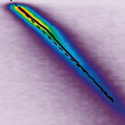Two is better than one for a smooth ride
Friction is a measure of how much of the kinetic energy in two surfaces sliding against each other is converted into heat. Sliding friction depends on numerous factors—the roughness and compressibility of the surfaces in contact, their atomic structure, as well as the inelastic scattering of electrons and phonons in either surface—but separating all of these contributions is difficult.
Graphene—atomically thin layers of carbon—is perhaps the ideal material in which to study friction since it can be produced with atomic precision and with few defects. Moreover, graphite (many layers of graphene) is a well-known solid lubricant. In a paper appearing in Physical Review Letters, Tobin Filleter and colleagues at McGill University in Canada and collaborators in the US and Germany have measured the frictional force on an atomic force microscope tip as it slides across single and double layers of graphene. Even though the absolute magnitude of the frictional force varies for different tips, they always find that friction on a single graphene layer is twice that of a double layer.
Filleter et al. argue that the contrast comes from intrinsic differences in how energy is dissipated in the two graphene structures. With angle-resolved photoemission, they show that electron-phonon coupling is much stronger in single-layer graphene. The result is that vibrations excited by a sliding tip tend to excite electrons and are much more quickly damped, increasing frictional losses. – Jessica Thomas





